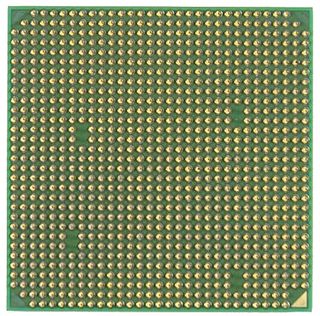AMD's Smart Strike: Athlon X2 BE-2350
The 45 W CPU: Athlon X2 BE-2350

As already mentioned, the Athlon X2 BE-2350 is a 65 nm part, based on the current DSL SOI process. AMD currently produces 65 nm products in the new Fab 36 in Dresden, Germany, and it is upgrading Fab 30 to run 65 nm as well. The processors have two cores, each of which can access a 512 kB L2 cache (1 MB total). While Intel utilizes a unified L2 cache architecture, AMD implements a crossbar switch to exchange data between the two L2 caches. Intel's advantage is that each processor can allocate cache dynamically, and thus can access the entire cache area for itself if required. Eventually, designs with dedicated L2 caches and a unified L3 cache will dominate multi core processors.
A memory controller is part of every Athlon 64 processor. In case of the Athlon 64 X2 family for Socket AM2, and for the new Athlon 64 BE as well, this is a DDR2-800 controller, supporting up to four memory modules. AMD also utilizes its well known HyperTransport interface at 1 GHz DDR speed, resulting in an interface bandwidth of 4 GB/s for each of upstream and downstream. As a consequence, the Athlon 64 BE processors can be deployed into all available Socket AM2 motherboards. You will have to upgrade your BIOS to support all processor features, such as Cool'n'Quiet, but the processor will run once your motherboard is able to cope with any 65 nm AMD processor.
Cool'n'Quiet requires BIOS and operating system support. For Windows XP you need a C'n'Q driver, but Vista natively supports this feature. Once enabled, the system will reduce the processor speed and processor voltage in several steps until 1.0 GHz at 1.1 V is reached. In this minimum P-state (performance state), the processor requires the least energy. Athlon platforms proved to be more efficient than Intel platforms, as the integrated memory controller is more energy-efficient than Intel's RAM controllers, which are part of the chipsets. The maximum P-state depends on the processor's maximum clock speed, and the TDP is determined at maximum load at the maximum P-state.
The Athlon X2 BE-2350 is clearly the better choice over the BE-2300, because the per-$1000 price differs by only $5, and the difference is 200 MHz. From an energy requirement standpoint this should not be an issue, as modern processors typically stay in energy-efficient operating modes whenever they run idle.


Stay on the Cutting Edge
Join the experts who read Tom's Hardware for the inside track on enthusiast PC tech news — and have for over 25 years. We'll send breaking news and in-depth reviews of CPUs, GPUs, AI, maker hardware and more straight to your inbox.
Current page: The 45 W CPU: Athlon X2 BE-2350
Prev Page Cheap And Efficient Dual Core Processors Next Page The Challenger: Intel Pentium Dual Core E2160